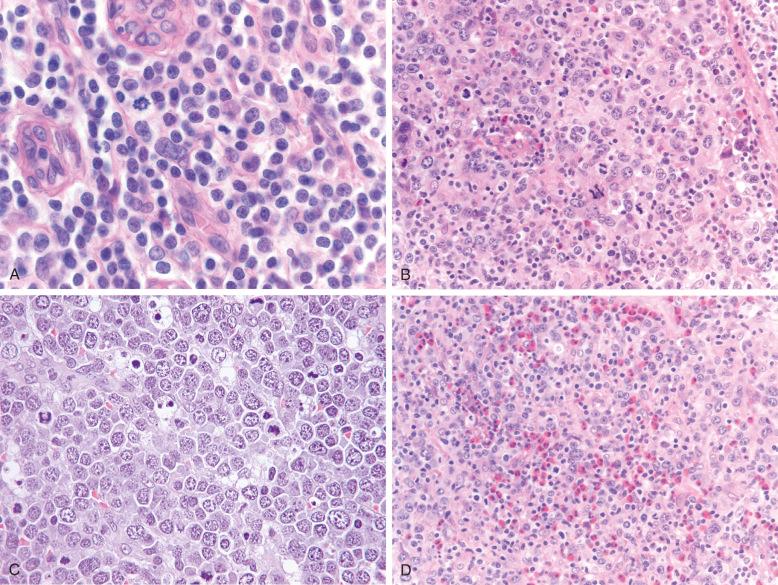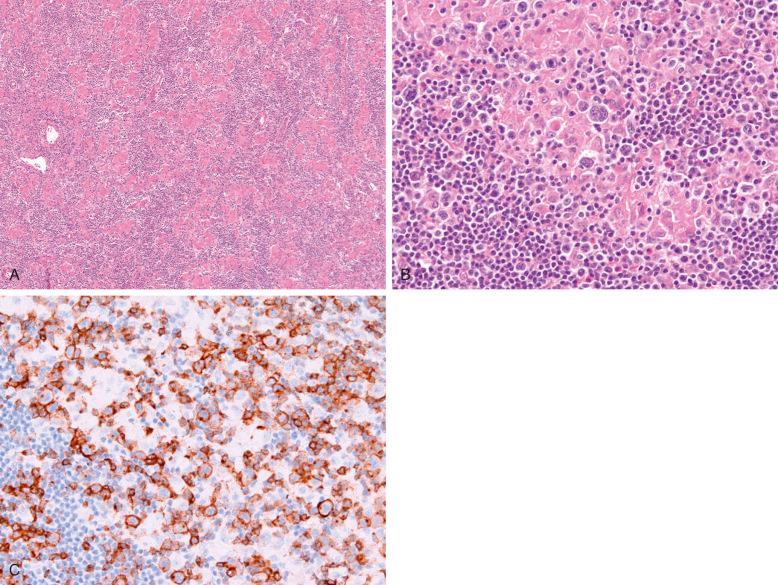Physical Address
304 North Cardinal St.
Dorchester Center, MA 02124
The category of the peripheral T-cell lymphoma, unspecified, introduced in the Revised European-American Lymphoma classification in 1994, was renamed peripheral T-cell lymphoma, not otherwise specified (PTCL, NOS) in the 2008 edition of the World Health Organization (WHO) classification, an appellation reflecting the expectations for better specification or subdivisions in the future. It encompasses per definition all mature T-cell neoplasms lacking specific features that would allow categorization within any of the better defined “specific” subtypes of post-thymic T-cell lymphoma/leukemia described in the WHO classification. Hence, other categories of T-cell lymphoma must be excluded before a diagnosis of PTCL, NOS is established. It is realized that this group is not likely to constitute one entity, and more recently gene expression profiling studies and immunohistochemical surrogate markers have led to identification of subtypes with prognostic relevance, such as derivation from Th1/Th2 subsets.
PTCL, NOS is overall rare but accounts for about 30% of non-cutaneous PTCLs worldwide. They are relatively more common in North America and in Europe compared with Asia, where other PTCL entities (human T-lymphotropic virus 1–associated and Epstein-Barr virus [EBV]–associated NK/T-cell neoplasms) are more prevalent. In North America, they are reported to represent about 35% of PTCLs. On the basis of an analysis of the French lymphoma registry over the past few years, PTCL, NOS accounted for 27% of the cases and was the second non-cutaneous PTCL in frequency after angioimmunoblastic T-cell lymphoma (36% of the cases).
The etiology of the disease, or more likely diseases, is unknown. In a minority of cases, associations with other clinical conditions have been reported. For example, patients with the lymphoproliferative variant of the hypereosinophilic syndrome, a condition associated with a clonal proliferation of interleukin-5–producing T cells, carry an increased risk for development of T-cell lymphomas. Several reports have documented single cases or small case series of patients with B-cell chronic lymphocytic leukemia (B-CLL) who developed EBV-negative PTCL, often featuring an activated cytotoxic immunophenotype, either anaplastic large cell lymphoma (ALCL) or PTCL, NOS in almost half of the cases studied. The interval between the diagnoses of B-CLL and PCTL in these patients was on average 5 years. Clonal populations of circulating T cells with large lymphocyte granular morphology, found in a subset of B-CLL patients, might be precursors to the development of cytotoxic PTCL in rare patients.
The disease tends to be diagnosed in older adults at a median age of 60 years, but all ages including children may be affected. There is a male predominance in most published series.
Most patients have nodal involvement, but any site may be affected, and in fact a combination of nodal and extranodal involvement in one or several sites is frequently encountered. Bulky disease is less commonly seen than in aggressive B-cell lymphomas. A majority of the patients (about 70%) have disseminated disease (stage III or IV) at the time of diagnosis, with infiltrates in the bone marrow, liver, spleen, gastrointestinal tract, or other extranodal tissues, including frequently the skin.
Constitutional symptoms, poor performance status, and elevated lactate dehydrogenase are reported in 40% to 60% of the cases, and approximately 50% to 70% of the patients have an intermediate to high International Prognostic Index (IPI) risk. Alternative prognostic models have been proposed for PTCL, NOS, but none appears to be clearly superior to the IPI. Blood eosinophilia, anemia, and thrombocytopenia are present at the time of the diagnosis in a minority of patients. The occurrence of a hematophagocytic syndrome in some patients is often associated with a rapidly fatal course, but it is more commonly associated with T-cell or NK-cell lymphomas, positive for EBV.
The morphologic spectrum of PTCL, NOS is extremely broad. Most commonly, the pattern of lymph node involvement is diffuse, but some cases present with an interfollicular or paracortical infiltrate ( Fig. 35-1 ). The cytology is typically pleomorphic (variable tumor cell morphology), with most cases containing a mixed population of smaller and larger cells ( Fig. 35-2 ). Many cases consist predominantly of medium-sized or large cells with irregular nuclei containing prominent nucleoli and many mitotic figures. Less common small pleomorphic T-cell lymphomas have a predominance of atypical small cells with irregular nuclei. Irregularity of nuclear contours may be a helpful hint to suspect the neoplastic nature of infiltrates composed predominantly of small cells. In some cases, there may be cells with clear cytoplasm, and Reed-Sternberg–like cells may be present. High endothelial venules are usually increased, and arborizing vessels are often abundant. Many cases have a polymorphous cellular composition, with an admixture of reactive cells, including small lymphocytes, eosinophils, histiocytes, B cells, and plasma cells. With relapse, the tumors tend to retain similar morphologic features and pattern of nodal involvement, but some cases are characterized by histologic progression with increased numbers of large cells.


Bone marrow involvement by PTCL, NOS is relatively frequent, reported in 20% to 30% of the cases. It can be diffuse, usually with hypercellularity and extensive replacement of the normal hematopoietic tissue, or less commonly focal, usually in a non-paratrabecular localization. As in the lymph nodes, there is a broad cytomorphologic spectrum; the infiltrates are often pleomorphic and associated with prominent vascularity, increased reticulin fibrosis, and an admixed reactive inflammatory infiltrate.
Splenic infiltrates ( Fig. 35-3, A and B ) may be in the form of single or multiple discrete lesions, as a micronodular pattern, or as diffuse parenchymal involvement of the red and white pulps. Localization to T-cell–dependent regions, such as the periarteriolar lymphoid sheath or marginal zone, may be seen. In the liver, there may be portal, lobular, or sinusoidal infiltrates. PTCL, NOS may be manifested primarily in the skin, and conversely cutaneous involvement is frequent in cases of systemic PTCL, NOS. There are several provisional categories of primary cutaneous T-cell lymphoma that are discussed in Chapter 41 . The pattern of the cutaneous infiltration by PTCL, NOS is variable and can be diffuse, nodular, or bandlike, and angiocentricity can be seen. Whereas epidermotropism is a more specific feature of mycosis fungoides and the Sézary syndrome, epidermotropism can be encountered in other forms. The pattern of involvement of other organs or viscera is variable; for example, lung infiltrates may have an interstitial distribution thickening the bronchovascular and alveolar septa ( Fig. 35-3, C and D ).

It has been proposed in the past to stratify PTCL, NOS into prognostic categories according to the morphology and the size of the predominant neoplastic cell. In that scheme, small cell tumors were categorized as low grade, and mixed medium and large cell types were categorized as high grade. However, in general, most PTCLs, NOS show an aggressive course, irrespective of the histologic and cytologic features, and therefore grading of these tumors is not generally recommended.
Three morphologic variants are recognized in the 2008 WHO classification. The lymphoepithelioid variant and the T-zone variant had been described as separate diseases at the time of the Kiel classification. The follicular variant, which was recognized later, is not discussed in this chapter as it has become clear that this peculiar PTCL, which may mimic follicular lymphoma, marginal zone lymphoma, progressively transformed germinal centers, or even nodular Hodgkin's lymphoma, features a strong T–follicular helper cell (T FH ) immunophenotype and presents clinical, biological, and pathologic features overlapping with those of angioimmunoblastic T-cell lymphoma. Thus, follicular PTCL is now considered part of the spectrum of nodal T FH -derived lymphomas rather than a variant of PTCL, NOS.
The lymphoepithelioid variant is rare, and the T-zone variant is even more exceptionally encountered. Identification of their specific features and delineation from other cases of PTCL, NOS may be subtle and subject to interobserver and intraobserver variability. Nevertheless, for the pathologist, it is useful to be familiar with these variants because they may be confused with other subtypes of lymphomas and with reactive processes.
The lymphoepithelioid variant, originally described by Lennert in 1952 as a variant of Hodgkin's disease, also known by the eponymous title Lennert's lymphoma, is characterized by a prominent reactive infiltrate of epithelioid histiocytes, distributed singly or more typically in small clusters ( Fig. 35-4 ). Most histiocytes are mononucleate, but multinucleate forms are occasionally seen. These cells may be so abundant that they can obscure the neoplastic cells, which are small atypical T cells with only slight nuclear irregularities. The infiltrate is diffuse but may be interfollicular. In addition to the small atypical cells, some medium-sized or large cells are also present, and some clear cells may be seen. Reed-Sternberg–like cells, eosinophils, and plasma cells are also commonly seen. Compared with other PTCLs, NOS, the lymphoepithelioid variant tends to remain confined to lymph nodes with infrequent extranodal involvement and may be associated with an overall better prognosis.

Become a Clinical Tree membership for Full access and enjoy Unlimited articles
If you are a member. Log in here